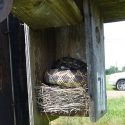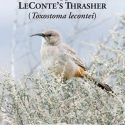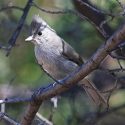 Photo ©
Keith Williams
Photo ©
Keith Williams

From Our Blog: Snakes On a Box!
Imagine you are a bluebird and you spot a snake near your nest. What do you do? According to a new study, you would weigh the risks of staying put against the time lost if you abandon your nest. It turns out, bluebirds can make proactive choices about what to do if they see a predator near the nest. Read more about this new study on our blog.
Want to stop snakes from visiting your boxes? Install a predator guard. It’s a passive, inexpensive way to keep snakes out of your boxes, while still respecting the important ecological roles of these legless creatures.

New Book on LeConte’s Thrasher
Congratulations to Jay Sheppard for publishing a new book on LeConte’s Thrashers. The Biology of a Desert Apparition: LeConte’s Thrasher (Toxostoma lecontei) is a thorough natural history of the species. The book incorporates nest records from NestWatch for the sections on reproduction, as well as photos and sound analysis from the Lab of Ornithology’s Macaulay Library.
The LeConte’s Thrasher is a poorly-known bird of the hot, dry deserts of the American Southwest and northwestern Mexico. Mr. Sheppard’s new book will be the authoritative text on the species for some time. NestWatch is also working with Mr. Sheppard to archive his own nest records in our database, so that these records can be permanently preserved after his retirement from the US Fish and Wildlife Service.

New Chapter: Aldea de Santa Fe
We are pleased to welcome a new NestWatch Chapter, our first in New Mexico. Aldea de Santa Fe is a residential community which boasts an active birding club and is officially certified as a Community Wildlife Habitat. Two years ago, a team of volunteers began a nest box project to benefit the Juniper Titmouse and other small cavity-nesting birds, including Mountain Chickadee and Bewick’s Wren. In a short amount of time, they have risen to become our single largest contributor of data from the state of New Mexico, as well as the biggest contributor of data on the little-known Juniper Titmouse. We are thrilled to have them as our newest Chapter, and keen to increase submissions from the juniper and piñon habitats of the Southwest.

Invasive Species Survey: Part Two
In March 2018, we initiated a new survey study on invasive species at nest boxes. If you participated in the first survey, thank you! An invitation to complete our final survey has been emailed to everyone who took the first one. If you didn’t receive it, please check your spam filter. Note that a few people experienced a broken link from the email, but all links are now working. As a reminder, everyone who completes both surveys is eligible to win a pair of Zeiss binoculars valued at $400.